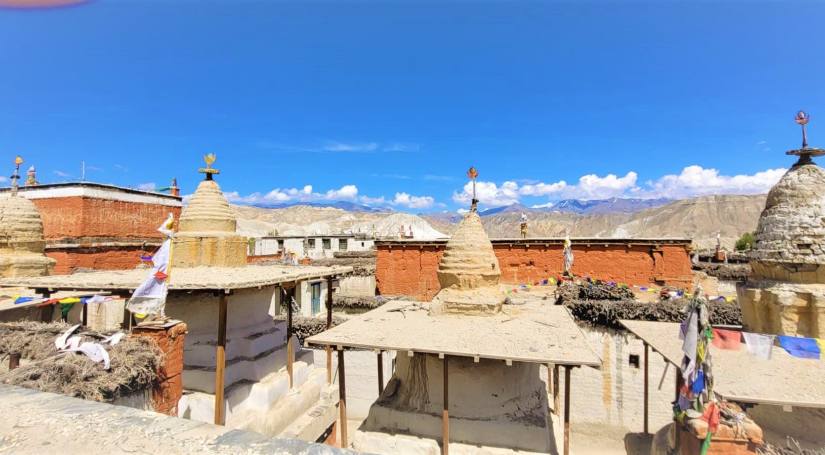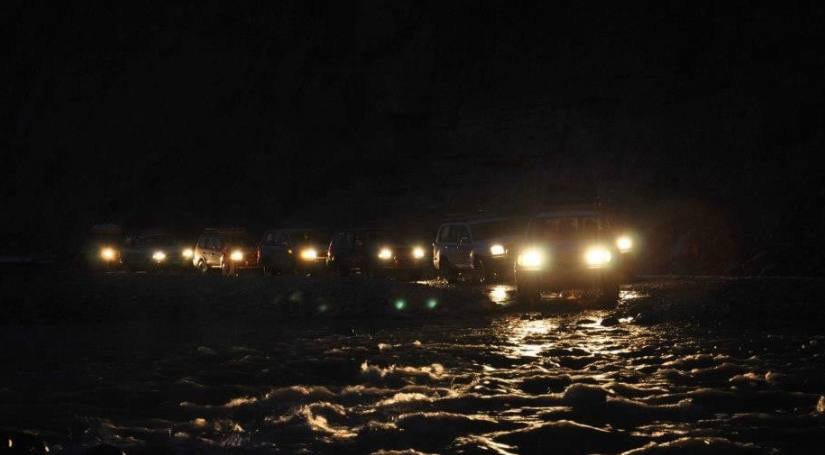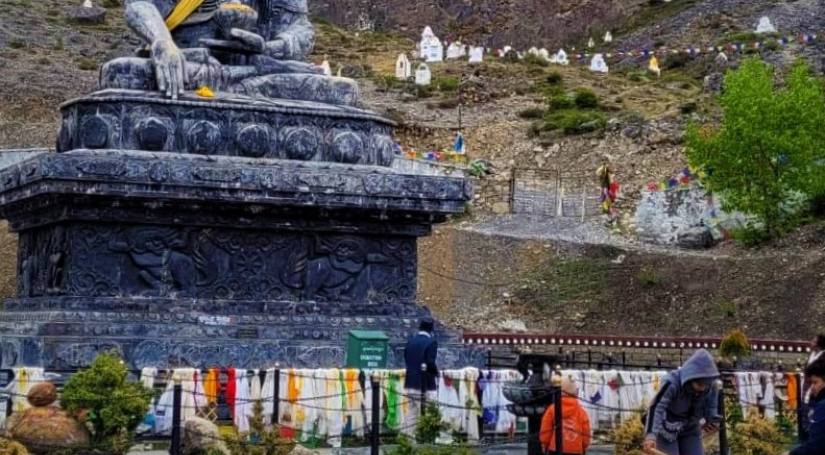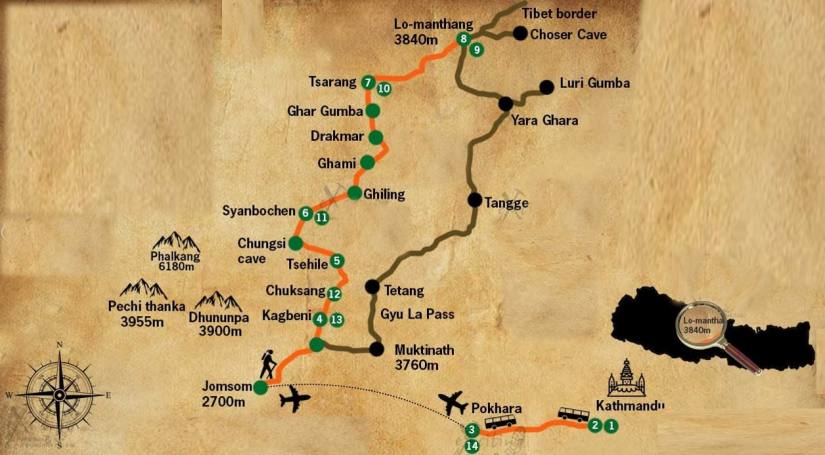UPPER MUSTANG TREK 2025 May 5th - 18 Days
-
Trip Code HTA-104
-
Duration: 18 Days
-
Trip Grade Moderate
About Trip:
Trip Introduction: -
Join our 18-day Upper Mustang Trek, an incredible journey into the remote Trans-Himalayan region shaped by Tibetan culture. The high desert area, stretching from the Tibetan border south to Kagbeni along the Kaligandaki River, is commonly referred to as Upper Mustang. This trek offers a chance to explore ancient monasteries, caves, and local tribes, while enjoying the stunning variety of landscapes along the way.
The adventure begins in the Kaligandaki region, known for the world’s deepest gorge, and continues through the barren, almost tree-less terrain of the Lo-Manthang Valley, passing steep rocky trails, ups and downs, and offering panoramic views of Nilgiri, Annapurna, Dhaulagiri, and many other Himalayan peaks. The route traverses high passes, glaciers, and alpine valleys, giving trekkers an unforgettable experience.
Upper Mustang has remained isolated for centuries, preserving its culture, lifestyle, and heritage. Traditional houses are built from stone and sun-baked mud bricks, and notable architectural sites include the city walls and four-story palace of Lo-Manthang. The region also hosts the vibrant Tiji Festival, celebrated in late winter or spring, which reflects Tibetan Buddhist traditions. Local customs, such as polyandry, where all brothers in a family share a single wife, may be fascinating for visitors unfamiliar with them.
Known as the “Last Forbidden Kingdom”, Mustang was restricted to outsiders until 1991, when the Nepalese government opened it for tourism. The people, who call themselves Lobas, still recognize their traditional leader, Jigme Palbar Bista, despite the formal monarchy being abolished in 2007. Visitors can meet Bista by request. Special permits are required to protect both the unique culture and fragile environment of the region.
The trek begins in Jomsom and follows the Kaligandaki River northwards to Kagbeni, the entry point to Upper Mustang, before reaching Lo-Manthang, the capital. This journey combines cultural immersion, breathtaking landscapes, and high-altitude trekking for an unforgettable Himalayan adventure.
Outline Itinerary
Outline Itinerary: -
Day 01: Arrive in Kathmandu [1300 m / 4264 ft]:
Day 02: Sightseeing in Kathmandu (1,400 m) and Brief discussion upon the
trip:
Day 03: Kathmandu to Pokhara [823m/2,700ft]: By Tourist Standard Vehicle
Day 04: Fly to Jomsom & trek to Kagbeni [2,858m/9,375ft]: 3-4 hrs
Day 05: Kagbeni to chele [3050m/10,004ft]: 5-6 hrs
Day 06: Chele to Syanbochen [3475m/11,398ft]: 6-7 hrs
Day 07: Syanbochen to Ghaymi [3520m/11,546ft]: 5-6 hrs
Day 08: Ghaymi to Charang [3500m/11,480ft]: 4-5 hrs
Day 09: Charang to Lo-Mangthang (3700m/12,136ft): 5-6 hrs
Day 10: Explore Lo-Mangthang:
Day 11: Lo-Mangthang to Drakmar [3810 m/12,500ft]: 6-7 hrs
Day 12: Dhakmar to Ghiling [3806m/12,484ft]: 5-6 hrs
Day 13: Ghiling to Chhuksang [3050m/10,004ft]: 5-6 hrs
Day 14: Chhuksang to Jomsom [2700/8,856ft]: 6-7 hrs
Day 15: From Jomsom Fly back to Pokhara:
Day 16- Flight Pokhara to Kathmandu after enjoying an amazing sunrise view from Sarangkot
Day 17 –Reserve day
Day 18: Fly Home: Farewell Friend
Cost Includes:
-
All airport/hotel transfers in a private vehicle.
-
3 Star-Level hotel Three nights in Kathmandu, including Pokhara two-night stay
-
Himalayan Traverse Duffel Bag
-
Welcome dinners
-
All accommodation and meals during the trek
-
During Kathmandu and Pokhara stay (Bed and Breakfast)
-
Pokhara city tour
-
Domestic flights (Pokhara-Jomsom-Pokhara-kathmandu) and airport departure taxes
-
An experienced English-speaking trek leader (trekking guide), assistant trek leader (If above 4 trekkers) and Sherpa porters to carry luggage (2 trekkers:1 porter) including their salary, insurance, equipment, flight, food and lodging
-
Tourist standard vehicle to Pokhara
-
Guided city tour in Kathmandu by private vehicle
-
Special permit 500$ US dollar per member
-
All necessary paper work and permits (ACAP and Upper Mustang special trekking permit)
-
Staff costs including their salary, insurance, equipment, food and accommodation
-
All government and local taxes
Cost Excludes:
- Nepal Visa fee (bring accurate USD cash and two passport photographs)
- International airfare to and from Kathmandu
- Entrance fee for the visiting places in Kathmandu and Pokhara
- Excess baggage charges
- Extra night accommodation/s in Kathmandu because of early arrival, late departure, early return from the mountain (due to any reason) than the scheduled itinerary
- Lunch and evening meals in Kathmandu (and also in the case you return early from the mountain than the scheduled itinerary)
- Travel and rescue insurance
- Emergency evacuation
- Personal expenses (phone calls, laundry, bar bills, battery recharge, extra porters, bottle or boiled water, shower etc)
- Personal equipment
- Special Tips for guides and porters should be given.
- Not mentioned in “what is included” section
- If additional days are acquired by the members more than 10 days in the mustang area for more than in special permit then per member (50$- a day), should be paid.
- Credit facility (The amount should be accurate.)
Trip Map
May 05th -Day 01: Arrival in Kathmandu (1,350m/4,428ft)
Upon our arrival at the Tribhuvan International Airport (TIA) in Kathmandu, we will be greeted by a representative from Himalayan Traverse who will take us to star level hotel. Overnight in Kathmandu.
May 06th -Day 02: Sightseeing in Kathmandu and Brief discussion upon the trip
After breakfast in the morning we start a small sightseeing in Kathmandu in the three famous UNESCO World heritage enlisted sites: “Pashupatinath Temple” the biggest temple for Hindus, “Swayambhunath Stupa” also known as the monkey temple which is one of the famous religious Stupa for Buddhists and “Boudhanath Stupa” the biggest Stupa in Nepal located in Kathmandu. After this short visit to religious sites we make early preparations for our trip and make sure everything is okay. As it is the second day, we will make you brief introduction on your trip and your guide/s too. At the evening we will host a welcome dinner offering typical Nepalese cuisine in one of the finest Nepalese Restaurants in Kathmandu. Overnight in Kathmandu Hotel.
-Included meals: Breakfast, Dinner
May 07th -Day 03: Kathmandu to Pokhara [823m/2,700ft]: Flight
After having breakfast in the morning, we go to the airport to fly to Pokhara. The flight takes about 30 minutes and offers a dramatic view of the gorge between two big mountains, Annapurna and Dhaulagiri. Once we arrive at Pokhara airport, our guide will take us to a hotel by the lake. The rest of the day is spent exploring the lake area, and we stay overnight at the hotel.-Bed and Breakfast
At this day you will be handed land cruiser Prados after being checked properly (For Members self-driving per 2 people, for member willing to have driver (Nepali), 1 for Nepali staffs with driver (who would help if any problem in vehicle in the trip)) for the rest of the trip: -
May 08th -Day 04 – Pokhara to Kalopani (2530m) overnight (7-8 hrs drive)
-Breakfast,Lunch & Dinner
May 09th -Day 05 – Kalopani to Ghami/Ghiling (3500m) (via jomsom-kagbeni) (8 hrs drive)-BLD
May 10th -Day 06 – Ghami to Lomanthang around sightseeing-chosar cave –Lomanthang (3840m) 4 hrs drive-BLD
May 11th -Day 07 - Lomanthang to Korala Border (above 4000m) sightseeing-Muktinath (8 hrs drive)-BLD
May 12th -Day 08 – Muktinath Darsan–Dhumba Lake-Jomsom (2700m) overnight 2-3 hrs drive-BLD
May 13th -Day 09 – Jomsom to Tatopani Hot Spring (3-4 hrs drive)-BLD
May 14th -Day 10 – Tatopani to Pokhara (4-5 hrs drive)
May 15th -Day 11 - Pokhara Sightseeing [823m/2,700ft]
Early morning around 7 am in Pokhara, we will enjoy the breathtaking mountain views. Pokhara is a city known for its lakes and offers stunning scenery of Dhaulagiri, Manaslu, Machhapuchhare, the Annapurna range, and other peaks. The afternoon will be spent exploring the most accessible and beautiful lake, Fewa Lake, and enjoying boating activities. We can relax and have dinner by the tranquil Fewa Lake. In the evening, there will be opportunities for shopping. We will spend the night in Sarangkot.
Pokhara City Tour:
Devi's Fall:
Devi’s Fall is one of the popular tourist attractions in Pokhara.
It is also known as Patale Chhango (underground waterfall). The waterfall is named after a Swiss woman, Ms. Devi. In 1961, while swimming near Fewa Dam with her husband, she was swept away by the sudden overflow of the dam into a deep gorge and died. Since then, the waterfall has been named Devi's Fall. It is an impressive waterfall located 2 km south of Pokhara airport. City buses and taxis are available for visiting this site.
Gupteswor Cave:
Opposite Devi’s Fall is a beautiful cave known as Gupteswor Cave.
The cave is large and requires proper preparation for exploration. It is also a popular pilgrimage site. A natural image of Lord Shiva is found beneath the earth. Many devotees visit the cave daily. The cave has well-maintained steps with sufficient lighting for entry. There is a small tunnel behind the Shiva image that connects the cave to Devi's Fall. This tunnel provides an adventurous underground view of Devi's Fall and is an exciting part of the cave. Visitors should take care while navigating this tunnel.
Mahendra Cave:
Mahendra Cave is another natural wonder in Pokhara.
It has not been fully explored and visitors are advised to have a torch or a guide. The cave management committee provides a torch or guide if requested. Mahendra Cave is named after the late King Mahendra and is located approximately 9 km north of Pokhara Airport. City buses and taxis are available to reach the cave. Nearby is another cave called Bat’s Cave or Chamere Gupha.
Bindabasini Temple:
Bindabasini Temple is a popular pilgrimage site located on a small hill about 4 km north of the airport.
It is regarded as the Shakti Pitha of goddess Bhagabati. The temple area is like a park and is ideal for sightseeing. There are also other temples nearby, including one dedicated to Lord Shiva.
Tibetan Refugee Camps:
There are three Tibetan refugee camps located near Pokhara.
One is 2 km south of the airport near Devi’s Fall at Chhorepatan, another is in Prithwichowk, and the third is 7 km north of the airport in Hemja. These camps offer an opportunity to learn about Tibetan culture, traditions, and lifestyle. Within the camps, there are handicraft centers.
Buddhist Monastery:
Known as Nyeshang Monastery, it was established in 1960 by Manangi Buddhists.
Situated at Matepani, approximately 4 km east of the airport, it is built on a small hill and offers a beautiful view of Pokhara city and the mountain ranges.
Seti River:
The Seti River is another mysterious natural wonder of Pokhara.
Originating from the Machhapuchhare glacier, it flows through the main city area. The river has a dramatic rush before going underground or disappearing into a deep gorge at Bagar. The gorge is narrow but very deep, with some sections going down over 60 meters. KI Sing Bridge, Mahendrapool, and Prithvichowk are the main spots to observe the underground river and hear its roaring sound. Interestingly, even during the rainy season, the swollen floodwater does not block the narrow gorge.
Included meals: Bed and Breakfast
This day the vehicle will be returned as in the conditions of before.
May 16th -Day 12: Morning Sunrise view on Sarangkot, Fly to Kathmandu
We fly to Kathmandu in the afternoon. Once we arrive, we are taken to our hotel. We spend the day relaxing, doing some last-minute shopping, or visiting any sights we didn't see on our first day in Kathmandu. We stay overnight in Kathmandu.Included meals: Breakfast
May 17th -Day 13: Final Departure
Your trip to Nepal is ending today! There's not much left to do except send emails to your travel friends and get your photos sorted. A guide will pick you up for the airport about 3 hours before your flight. On the way back, you'll have lots of time to think about your next visit to the amazing country of Nepal.
(Note: The Trip Should be confirmed as soon as possible so that we are able to maintain the services as per itinerary, we hope you will cooperate with us and understand.)
You May Also Like
- Everest Base Camp Trek via Gokyo Lake 13th-September 2024(Full-Board)
- Lobuche East(6,119m/20,076ft.) Climbing With Everest Base Camp Trek Via Gokyo lake(Full-Board)
- Tibet (Kharta & Khangshung Valley) Trek with Everest Base Camp Trip 2025 (Full-Board Service)
- Chulu West with Annapurna Expedition
- UPPER MUSTANG TIJI Festival Trek 2025 April-27th (Full-Board)
- Mt. Him lung Himal (7,126m) Short Expedition-2024 (Full-Board) Service
- Pikey Peak with Everest Base Camp Trek Via Heli Ride- 2025 December-25th (New year Special)
- Mt. Everest Expedition-8848.86m (60 Days) Nepal South Side, Full-Board Services - 2026 April-05th
- Mt. Everest Expedition Nepal South Side & Lhotse- Full Board Services(April-5th)
- Island peak Climbing With Everest Base Camp Trek
- Himlung Himal Expedition
- Mt. Manaslu Expedition August-29th(Full-board)
- Mera Peak Climbing via Phaplu
- Mt. Everest Expedition (60 days) Nepal South Side Full Board Services - 2025 Spring: April/May/June
- (Christmas & New Year’s Special 2025 December -22) - Covering All World Heritage Sites (City Tour Program- (Full-board) & Mountain Flight to Everest Region.)
- Pikey Peak Trail-2026 Christmas and New Year’s Special (Full Board)
- UPPER MUSTANG OVERLAND TIJI TOUR 2025 May 04th (FULL-BOARD SERVICE)
- Mt. Amadablam Expedition
Trek to Langtang
We first met Dorjee Sherpa in 2012 and did a trek with him to Langtang before it was devastated in the earthquake. We quickly fell in love with the himalayas, the Nepalese people, their culture, and Dorjee shepa. The Langtang trek was a beautiful trek and a great introductory to the…
 Matt massey, United StatesDecember 22, 2025
Matt massey, United StatesDecember 22, 2025
Trek to Tyangboche
Just got home from our second trek in the Himalayas with Dorjee sherpa. We treked to tengboche for the mani rimdu festival. The festival was incredible and the mountains are magnificent. Dorjee is a great guide and we really enjoyed staying at his Buddha lodge and meeting his wonderful family.
 Matt massey, United StatesDecember 22, 2025
Matt massey, United StatesDecember 22, 2025
Mani Rimdu Festival trek
My family and friends from Maui completed a 10 day trek through Sagarmatha National Park to Tengboche to view the Mani Rimdu Festival in November . Our Guide Dorjee Sherpa and his associates arranged a fantastic trip for us. We stayed at his Buddha Lodge in Phakding and were treated very…
 Kevin Horan, NepalDecember 22, 2025
Kevin Horan, NepalDecember 22, 2025
Have fun with trust!
I spent very memorable days in the Everest region in Nepal. I used to dream to see this highest peak of the world and now I arrested it in my camera. My guide arranged everything and helped me a lot. He did not let me feel tired and boring.
 Austin, Netherlands AntillesDecember 22, 2025
Austin, Netherlands AntillesDecember 22, 2025
Certificate & Partners










